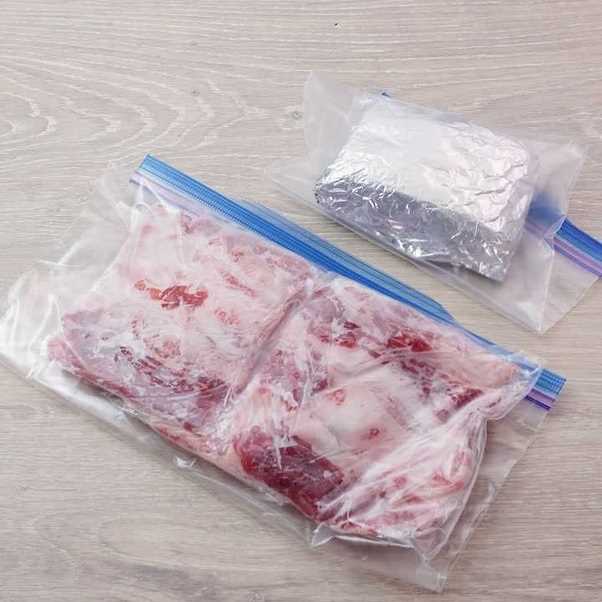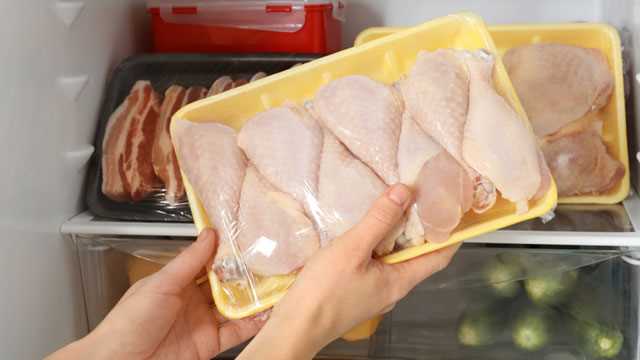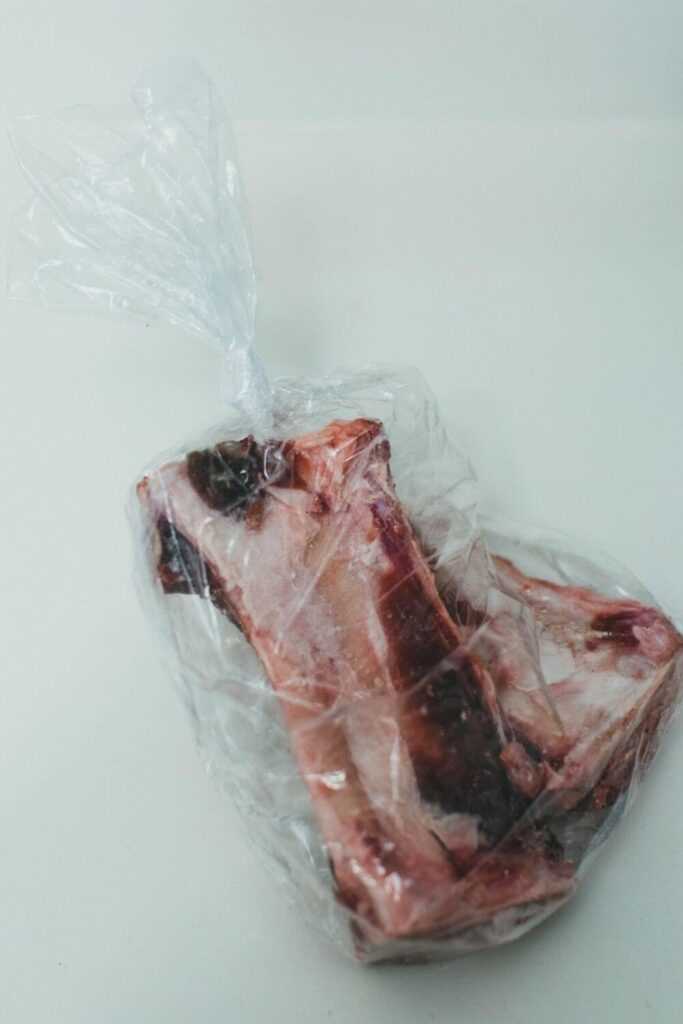
When it comes to storing meat in the refrigerator, there seem to be endless debates and opinions on the best practices. One common method that many people use is leaving meat in a plastic bag before placing it in the fridge. But is this a safe and healthy way to store meat? Let’s delve into the topic.
Firstly, it is important to understand the purpose of storing meat in a plastic bag. The main reason why people use this method is to prevent the meat from coming into direct contact with other foods in the fridge, thus reducing the risk of cross-contamination. Additionally, the plastic bag helps to seal in the meat’s natural juices and flavors, keeping it moist and tender.
However, it is crucial to note that not all plastic bags are created equal when it comes to food storage. It is essential to use bags specifically designed for food storage and made from materials that are safe for contact with food. Look for bags that are labeled as “food grade” or “BPA-free” to ensure they do not release harmful chemicals into the meat.
While using a plastic bag to store meat may seem convenient, it’s important to consider potential risks. Plastic bags can create a moist environment, which may promote the growth of bacteria and lead to foodborne illnesses if the meat is not handled and stored properly. Therefore, it’s crucial to follow proper food safety practices, including storing meat at the correct temperature and discarding it if it shows any signs of spoilage.
- Is Leaving Meat in Plastic Bag Safe?
- Potential Contamination
- Temperature and Moisture Control
- Potential Risks of Leaving Meat in a Plastic Bag
- Bacterial Growth and Foodborne Illness
- How to Properly Store Meat in the Fridge
- 1. Wrap it properly
- 2. Keep it separate
- 3. Store in the coldest part of the fridge
- Alternatives to Plastic Bags for Storing Meat
- Tips for Safe and Healthy Meat Storage
- 1. Keep meat refrigerated
- 2. Store meat in sealed containers or bags
- 3. Use separate cutting boards and utensils
- 4. Freeze meat if not using within a few days
- 5. Check for spoilage before consuming
- Q&A
- Can I leave meat in a plastic bag in the fridge?
- Is it healthy to leave meat in a plastic bag in the fridge?
- Can leaving meat in a plastic bag in the fridge cause any health risks?
- How long can I safely leave meat in a plastic bag in the fridge?
- What precautions should I take when leaving meat in a plastic bag in the fridge?
Is Leaving Meat in Plastic Bag Safe?
Many people wonder whether it is safe to leave meat in a plastic bag in the refrigerator. While it may seem convenient to store meat in a plastic bag, there are some safety and health concerns to consider.
Potential Contamination
One of the main concerns with leaving meat in a plastic bag is the potential for contamination. Plastic bags are not airtight and can easily tear or puncture, allowing bacteria to enter and spoil the meat. This can lead to foodborne illnesses such as salmonella or E. coli.
Temperature and Moisture Control
Another issue with using plastic bags for meat storage is the lack of temperature and moisture control. Plastic bags do not provide insulation or proper ventilation, which can lead to uneven temperatures and moisture accumulation. This can cause the meat to spoil faster and increase the risk of bacterial growth.
To ensure the safety of your meat, it is recommended to store it in airtight containers or freezer bags specifically designed for storing food. These containers provide better protection against contamination and help maintain proper temperature and moisture levels.
- Always check the packaging of the meat for any specific storage instructions.
- If transferring meat from its original packaging to a plastic bag, make sure the bag is sturdy and free of any holes or tears.
- Store meat in the coldest part of the refrigerator, typically the back of the bottom shelf.
- Do not leave meat in a plastic bag for longer than necessary. Use it within a few days or consider freezing it for longer storage.
Overall, it is best to exercise caution when storing meat in a plastic bag in the fridge. Opting for proper food storage containers and following recommended storage guidelines can help ensure the safety and quality of your meat.
Potential Risks of Leaving Meat in a Plastic Bag

While it may seem convenient to leave meat in a plastic bag in the fridge, there are several potential risks associated with this practice. Here are some of the main concerns to consider:
- Bacterial growth: Plastic bags can create a moist environment that promotes the growth of bacteria, including harmful pathogens like Salmonella and E. coli. These bacteria can multiply rapidly and contaminate the meat, increasing the risk of foodborne illnesses.
- Decreased shelf life: Storing meat in a plastic bag can accelerate spoilage. The lack of airflow and moisture buildup inside the bag can lead to a shorter shelf life for the meat, causing it to spoil more quickly.
- Plastic leaching: Plastic bags may contain harmful chemicals that can leach into the meat over time. Bisphenol A (BPA) and phthalates are common additives in plastic, and exposure to these chemicals has been linked to various health issues, including hormonal imbalances and reproductive problems.
- Loss of quality: Leaving meat in a plastic bag for an extended period can affect its texture, taste, and overall quality. The trapped moisture and lack of ventilation can lead to a slimy or off-putting texture, as well as an unpleasant smell or taste.
- Cross-contamination: Placing raw meat in a plastic bag without proper separation can result in cross-contamination. If the bag comes into contact with other foods in the fridge, it can transfer bacteria and potentially contaminate them.
To ensure the safety and quality of your meat, it is best to store it properly in airtight containers or wrap it securely in freezer paper or aluminum foil. These options provide better protection against bacterial growth, help maintain the meat’s freshness, and reduce the risk of plastic leaching.
Remember to always follow food safety guidelines and discard any meat that shows signs of spoilage or has exceeded its recommended storage time.
Bacterial Growth and Foodborne Illness
When meat is left in a plastic bag in the fridge, it creates an environment conducive to bacterial growth. Bacteria naturally exist on the surface of raw meat, and they can multiply quickly under the right conditions.
One of the main concerns of bacterial growth in meat is the risk of foodborne illness. Bacteria such as Salmonella, E. coli, and Campylobacter can contaminate meat and cause infections when consumed. These infections can lead to symptoms such as vomiting, diarrhea, abdominal pain, and in some cases, more severe complications.
Proper food handling and storage practices are essential to prevent bacterial growth and reduce the risk of foodborne illness. Storing meat in a plastic bag in the fridge can create an environment where bacteria can thrive. The plastic bag can trap moisture, especially if the meat is not tightly sealed, providing the perfect conditions for bacteria to multiply.
If meat is left in a plastic bag in the fridge for an extended period, it increases the chances of bacterial contamination. The longer the meat is left in the bag, the higher the risk of bacterial growth becomes.
To ensure food safety and prevent foodborne illness, it is best to store meat properly. This means removing it from the plastic bag and placing it in a sealed container or wrapping it tightly with aluminum foil or freezer paper. This will help to inhibit bacterial growth and keep the meat fresh for a longer period.
It is also important to ensure that the fridge is maintained at the proper temperature. The temperature should be below 40°F (4°C) to slow down bacterial growth. Regularly cleaning the fridge and avoiding cross-contamination by separating raw meat from other foods can further reduce the risk of foodborne illness.
By following proper food safety guidelines and taking necessary precautions, you can minimize the risk of bacterial growth and foodborne illness associated with storing meat in a plastic bag in the fridge.
How to Properly Store Meat in the Fridge
Properly storing meat in the fridge is essential for maintaining its freshness and preventing the growth of harmful bacteria. Follow these simple steps to ensure the safety and quality of your meat:
1. Wrap it properly
When storing meat in the fridge, it’s important to wrap it tightly to prevent any air exposure. Air can cause the meat to spoil faster and allow bacteria to grow. Use plastic wrap or airtight containers to seal the meat and keep it fresh.
2. Keep it separate

It’s essential to store raw meat separately from other foods to prevent cross-contamination. Raw meat contains bacteria that can be easily transferred to other foods, increasing the risk of foodborne illnesses. Use separate containers or place the meat on the bottom shelf to prevent any drips or leaks.
3. Store in the coldest part of the fridge
The coldest part of the fridge is usually the back of the bottom shelf, where the temperature is most consistent. This area is ideal for storing meat as it helps maintain a low temperature and prevents the growth of bacteria. Avoid storing meat in the fridge door as the temperature fluctuates when the door is opened frequently.
By following these simple guidelines, you can ensure the safety and quality of your stored meat. Properly stored meat will last longer and minimize the risk of foodborne illnesses.
Alternatives to Plastic Bags for Storing Meat
When it comes to storing meat, it’s important to choose the right packaging to ensure both the safety and the quality of the meat. While plastic bags are commonly used for this purpose, there are several alternatives that you can consider:
- Reusable silicone bags: These bags are a great option as they are sturdy, leak-proof, and can be easily washed and reused. They also help reduce plastic waste.
- Glass containers with airtight lids: Glass containers are a safe and eco-friendly choice for storing meat. They are reusable, do not release any harmful chemicals, and are transparent, allowing you to easily see the contents inside.
- Paper wraps: Wrapping meat in butcher paper is a traditional method that is still widely used today. It allows the meat to breathe and eliminates the risk of any plastic chemicals leaching into the meat.
- Beeswax wraps: These wraps are made from cotton fabric coated with beeswax, which provides a natural and breathable seal. They are reusable and can be easily cleaned with mild soap and water.
- Vacuum-sealed bags: Vacuum-sealed bags remove air from the packaging, helping to preserve the freshness and flavor of the meat. They are available in reusable options, reducing waste.
It’s important to note that when using alternative packaging for storing meat, proper handling and storage practices should still be followed. Always ensure that the meat is properly sealed and stored at the right temperature to prevent spoilage and maintain food safety.
Tips for Safe and Healthy Meat Storage
Proper storage of meat is essential to prevent bacterial growth and maintain its quality and safety. Here are some tips for safe and healthy meat storage:
1. Keep meat refrigerated
Meat should be stored in the refrigerator at a temperature below 40°F (4°C). This helps to slow down bacterial growth and keep the meat fresh for a longer time.
2. Store meat in sealed containers or bags
It’s important to store meat in sealed containers or bags to prevent cross-contamination. Plastic bags or airtight containers can help keep the meat separate from other foods and prevent the spread of bacteria.
3. Use separate cutting boards and utensils
When preparing meat, it’s crucial to use separate cutting boards and utensils to avoid cross-contamination. Using dedicated cutting boards and utensils for meat can help prevent the spread of harmful bacteria.
4. Freeze meat if not using within a few days
If you’re not planning to use the meat within a few days, it’s best to freeze it. Freezing helps to preserve the quality of the meat and prevents bacterial growth. Make sure to use freezer-safe bags or containers to prevent freezer burn.
5. Check for spoilage before consuming
Before cooking or consuming meat, always check for any signs of spoilage. This includes an off smell, slimy texture, or discoloration. If you notice any of these signs, it’s best to discard the meat to avoid the risk of foodborne illness.
| Meat Type | Refrigeration Time | Freezer Time |
|---|---|---|
| Ground meat (beef, pork, poultry) | 1-2 days | 3-4 months |
| Steaks (beef, pork, lamb) | 3-5 days | 6-12 months |
| Poultry (chicken, turkey) | 1-2 days | 9-12 months |
| Pork (chops, roasts) | 3-5 days | 4-6 months |
By following these tips, you can ensure that your meat stays safe and healthy for consumption. Proper storage is essential to prevent foodborne illnesses and maintain the quality of the meat.
Q&A
Can I leave meat in a plastic bag in the fridge?
Yes, it is generally safe to leave meat in a plastic bag in the fridge. The plastic bag helps to contain any liquids or juices that may leak from the meat, preventing cross-contamination with other foods. However, it is important to make sure that the plastic bag is sealed tightly to prevent any air from entering and to maintain the freshness of the meat.
Is it healthy to leave meat in a plastic bag in the fridge?
Leaving meat in a plastic bag in the fridge is generally considered healthy as long as proper food safety practices are followed. The plastic bag helps to prevent the spread of bacteria and cross-contamination with other foods. However, it is important to ensure that the meat is stored at the right temperature and consumed within the recommended timeframe to maintain its quality and safety.
Can leaving meat in a plastic bag in the fridge cause any health risks?
Leaving meat in a plastic bag in the fridge does not pose significant health risks if proper food safety guidelines are followed. However, if the meat is not stored at the correct temperature or if it is left in the fridge for too long, it can potentially lead to the growth of harmful bacteria. It is important to store meat properly and consume it within the recommended time to reduce the risk of foodborne illnesses.
How long can I safely leave meat in a plastic bag in the fridge?
The amount of time that meat can be safely left in a plastic bag in the fridge depends on the type of meat and its freshness. In general, raw meat can be safely stored in the fridge for 1-2 days. However, it is always best to check the expiration date or use-by date on the packaging and consume the meat within that timeframe for optimal safety and quality.
What precautions should I take when leaving meat in a plastic bag in the fridge?
When leaving meat in a plastic bag in the fridge, it is important to take certain precautions to ensure food safety. Make sure the plastic bag is clean and in good condition, without any holes or tears. Ensure the bag is sealed tightly to prevent air from entering and to maintain the freshness of the meat. Store the meat on the lowest shelf of the fridge to prevent its juices from dripping onto other foods. Finally, always check the expiration or use-by date on the meat packaging and consume it within the recommended time for optimal safety.